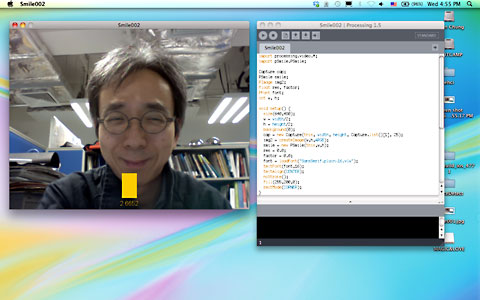People switching from Processing to OpenFrameworks or other more serious development platforms due to performance consideration. I have done a few searches and found that there are a number of libraries using different Java bindings of OpenCL, Vertex Buffer Object, Pixel Buffer Object, and even DirectShow. I wonder if it is more possible to use Processing in production environment where performance is important.
I have done a test to compare using live webcam video stream with traditional texture method and another one with pixel buffer object. The performance difference is noticeable and significant using my MacBook Pro. I do not record the videos as it may distort the real time performance.
This is the ‘traditional’ method.
import processing.video.*; import processing.opengl.*; float a; Capture cap; PImage img; void setup() { println(Capture.list()); size(640, 480, OPENGL); hint(ENABLE_OPENGL_2X_SMOOTH); hint(DISABLE_DEPTH_TEST); a = 0; img = loadImage("tron.jpg"); frameRate(30); cap = new Capture(this, width, height, 30); cap.read(); textureMode(NORMALIZED); } void draw() { background(0); image(img, 0, 0); translate(width/2, height/2, 0); float b = a*PI/180.0; rotateY(b); rotateX(b); beginShape(QUADS); texture(cap); vertex(-320, -240, 0, 0, 0); vertex( 320, -240, 0, 1, 0); vertex( 320, 240, 0, 1, 1); vertex(-320, 240, 0, 0, 1); endShape(); a += 1; a %= 360; } void captureEvent(Capture _c) { _c.read(); } |
import processing.video.*; import processing.opengl.*; import javax.media.opengl.*; import java.nio.IntBuffer; float a; PGraphicsOpenGL pgl; GL gl; PImage img; int [] tex = new int[1]; int [] pbo = new int[1]; Capture cap; void setup() { println(Capture.list()); size(640, 480, OPENGL); hint(ENABLE_OPENGL_2X_SMOOTH); hint(DISABLE_DEPTH_TEST); a = 0; img = loadImage("tron.jpg"); frameRate(30); pgl = (PGraphicsOpenGL) g; cap = new Capture(this, width, height, 30); cap.read(); gl = pgl.gl; gl.glGenBuffers(1, pbo, 0); gl.glBindBuffer(GL.GL_PIXEL_UNPACK_BUFFER, pbo[0]); gl.glBufferData(GL.GL_PIXEL_UNPACK_BUFFER, 4*cap.width*cap.height, null, GL.GL_STREAM_DRAW); gl.glBindBuffer(GL.GL_PIXEL_UNPACK_BUFFER, 0); gl.glGenTextures(1, tex, 0); gl.glBindTexture(GL.GL_TEXTURE_2D, tex[0]); gl.glTexParameteri(GL.GL_TEXTURE_2D, GL.GL_TEXTURE_MIN_FILTER, GL.GL_NEAREST); gl.glTexParameteri(GL.GL_TEXTURE_2D, GL.GL_TEXTURE_MAG_FILTER, GL.GL_NEAREST); gl.glTexParameteri(GL.GL_TEXTURE_2D, GL.GL_TEXTURE_WRAP_S, GL.GL_CLAMP); gl.glTexParameteri(GL.GL_TEXTURE_2D, GL.GL_TEXTURE_WRAP_T, GL.GL_CLAMP); gl.glTexImage2D(GL.GL_TEXTURE_2D, 0, GL.GL_RGBA, cap.width, cap.height, 0, GL.GL_BGRA, GL.GL_UNSIGNED_BYTE, null); gl.glBindTexture(GL.GL_TEXTURE_2D, 0); } void draw() { background(0); image(img, 0, 0); gl = pgl.beginGL(); gl.glColor3f( 1.0f, 1.0f, 1.0f); gl.glEnable(GL.GL_TEXTURE_2D); gl.glBindTexture(GL.GL_TEXTURE_2D, tex[0]); gl.glBindBuffer(GL.GL_PIXEL_UNPACK_BUFFER, pbo[0]); gl.glTexSubImage2D(GL.GL_TEXTURE_2D, 0, 0, 0, cap.width, cap.height, GL.GL_BGRA, GL.GL_UNSIGNED_BYTE, 0); gl.glBufferData(GL.GL_PIXEL_UNPACK_BUFFER, 4*cap.width*cap.height, null, GL.GL_STREAM_DRAW); IntBuffer tmp1 = gl.glMapBuffer(GL.GL_PIXEL_UNPACK_BUFFER, GL.GL_WRITE_ONLY).asIntBuffer(); tmp1.put(cap.pixels); gl.glUnmapBuffer(GL.GL_PIXEL_UNPACK_BUFFER); gl.glBindBuffer(GL.GL_PIXEL_UNPACK_BUFFER, 0); gl.glTranslatef(width/2, height/2, 0); gl.glRotatef(a, 1, 1, 0); gl.glBegin(GL.GL_QUADS); gl.glTexCoord2f(0.0f, 0.0f); gl.glVertex3f(-320, -240, 0); gl.glTexCoord2f(1.0f, 0.0f); gl.glVertex3f( 320, -240, 0); gl.glTexCoord2f(1.0f, 1.0f); gl.glVertex3f( 320, 240, 0); gl.glTexCoord2f(0.0f, 1.0f); gl.glVertex3f(-320, 240, 0); gl.glEnd(); gl.glBindTexture(GL.GL_TEXTURE_2D, 0); pgl.endGL(); a += 1.0; a %= 360; } void captureEvent(Capture _c) { _c.read(); } |




